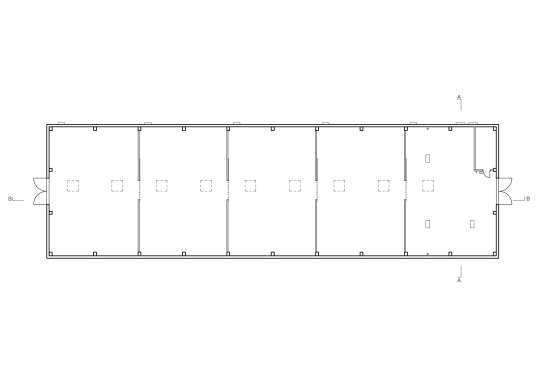

For much of our history as a species, the threat of chronic food shortage and malnutrition has loomed over us.
Fortunately, due to global economies and remarkable advances in technology and agriculture, most of the people reading this will never need to worry about starvation.
But ironically, even as people in industrialized nations have largely overcome the problem of famine, we now must battle the consequences of excessive abundance of readily accessible food. All over the world, modern societies are confronting the challenge of obesity and diseases emanating from obesity.
An analysis of trends in adult body mass published in the Lancet puts the progression of this public health crisis into useful historical perspective: It revealed that the number of obese individuals has risen from 105 million in 1975 all the way to 641 million as of 2016. Over the past 40 years, we have gone from a world in which prevalence of underweight was more than double that of obesity, to a world in which people with obesity outnumber those who are underweight.
There has been vigorous debate on what aspects of our food supply are responsible for this relatively rapid shift in collective body composition. Recently, sugar has come under particularly fierce scrutiny, and understandably so. We do know that overconsumption of simple sugars can contribute to obesity and related diseases. This is particularly evident in research examining the impact of sugary soft drinks. One meta-analysis, for instance, found that for every additional 12-ounce serving of sugar-sweetened beverage consumed each day, BMI increased by 0.08 units in children and adolescents.
So what about fruit? Most types of fruit are naturally high in simple sugars, and we have virtually unlimited access to fruit year-round, even as I write this now in the dead of winter. Could sweet fruit be a hidden contributor to the obesity epidemic? Indeed, certain health gurus out there have characterized fruit as “watery bags of sugar” on this basis, and further stating that fruit will make you fat.
But is that true? And what is the best way to go about answering a question like this?
And that brings me to our guest.
GUEST
On this episode of humanOS Radio, we welcome a familiar face back to the show – Stephan Guyenet. Stephan has a Ph.D in neurobiology and is an all-around smart guy. He spent 12 years at the University of Washington researching the neuroscience underlying body fat regulation. You can find more of his excellent work at his blog. Stephan is also the author of The Hungry Brain – Outsmarting the Instincts That Make Us Overeat.
There is perhaps nobody else, at least in our view, who has done more in recent years to help the general public understand the evidence related to energy regulation and weight control. This is why Dan chose to collaborate with him on the Ideal Weight Program, and it is why he is uniquely qualified to address the question of whether fruit actually does make you fat.
We do know that refined sugar can readily increase energy intake, and in turn increase body fatness. But as you probably already realize, fruit differs from refined sugar (and foods that are heavily enriched in added sugars) in several important respects.
For one thing, fruit contains substantial amounts of water, and most fruits are very low in fat. This means that on a per unit basis, fruit is low in calories relative to its total volume, especially in contrast to western processed fare. (A good illustration of this principle would be to compare 200 calories of blackberries next to, say, 200 calories of butter.)
Fruit is also high in fiber and in biologically active compounds called phytochemicals, both of which seem to enhance satiety. Fiber creates a viscous gel in the small intestine, which slows down gastric emptying and may reduce total energy extraction. And certain phytochemicals, like flavonoids, have been shown to block enzymes that break down starches, and may also alter secretion of hormones that affect satiety. So in theory, you not only feel fuller eating fruits, but you may also not absorb as many calories as the nutrition label would suggest. Additionally, both dietary fiber and phytochemicals also influence the ecology of the gut microbiota, generally in ways that seem to favor leanness.
Finally, all of the above factors tend to reduce the palatability and reward value of fruit. Meaning that you are way less likely to overdo it eating blueberries or bananas, compared to your favorite candy or soft drink (unless, perhaps, you are one of these people).
So, there does appear to be an array of plausible molecular and physiological mechanisms through which fruit could actually promote healthy body weight, despite its sugar content. But some might wonder if all of this really matters.
Last year, Stephan decided to answer the question of whether fruit was fattening in the most rigorous manner possible. Specifically, he wanted to look at the impact of whole, fresh fruit (as opposed to fruit juice, or other processed forms of fruit) on energy intake and adiposity. To that end, he conducted a systematic review of randomized controlled trials and prospective cohort studies, and that is what we have brought him on to discuss.
To learn about what he found, and what it means, check out the interview below!
LISTEN HERE
On Soundcloud | Spotify | Apple Podcasts | Google Play | Stitcher | iHeartRadio | Overcast.fm | YouTube
YOUTUBE
SUPPORT
Have you considered becoming a Pro member of humanOS.me? It costs just $9.99 per month, and when you go Pro, you get access to all our courses, tools, recipes, and workouts. Pro members also support our work on blogs and podcasts, so thanks!
LEAVE A REVIEW
If you think other people would benefit from listening to this show, you can help us spread the word by leaving a review at iTunes. Positive reviews really help raise the profile of our show!
TRANSCRIPT
| Stephan Guyenet: | 00:00:00 | Most of these studies reported significant reductions in weight in the higher fruit group or trends in that direction. |
| Dan Pardi: | Welcome back everyone. Today I have with me Stephen Guyenet. You might already be familiar with him and his work. He has been on this show several times before. Stephen has a PhD in neuroscience from the University of Washington and he spent 12 years researching the neuroscience that underlies body fat regulation. He is also the co-creator of the Ideal Weight Program here at humanOS, and is the author of the book The Hungry Brain, which I highly recommend to those who are interested in the science of weight control. So why is he back today? Well, earlier this year he wrote a review examining a topic that has drawn some vigorous debate in the health community, the effects of fruit on appetite and weight regulation. Refined sugar has long been perceived as a likely culprit in the obesity epidemic, but in recent years sugar has attracted even more scrutiny. And some argue that even naturally occurring sources of sugar such as fruit may drive obesity as well. Government guidelines, health organizations, and dietitians have continued to recommend consuming fruits and vegetables as a part of a healthy diet. | |
| 00:00:08 | But is it possible that fruit carries the same obesogenic properties that are typically attributed to refined sugar? In other words, does fruit make you fat? Earlier this year Stephan resolved to try to answer this question. He had conducted a systematic review of randomized controlled trials and prospective cohort studies to determine the impact of fruit consumption on energy intake as well as body fatness, and we’ve brought him here to discuss what he found. So Stephan, welcome back to the show. | |
| Stephan Guyenet: | Thanks. Good to be here. | |
| Dan Pardi: | Okay, so what inspired you to research and write this review in particular? | |
| Stephan Guyenet: | 00:01:42 | Sugar is a big deal right now. It’s getting a lot of attention in the press, it’s getting a lot of attention in the research community. And some people, at least in the mainstream media environment are suggesting that maybe it’s the primary cause of obesity and chronic disease. Maybe it’s the primary cause of obesity, primary cause of type two diabetes, primary cause of cardiovascular disease. And I think this is part of an ongoing backlash against the prevailing message in the ’80s and ’90s that fat was the big thing to worry about and sugar wasn’t that bad. I think what we’re seeing today is the research is suggesting that a high intake of refined sugar is pretty bad. It’s probably not something you want to do, and so the pendulum is swinging in the other direction. People are paying a lot of attention to sugar, and at the same time they’re forgetting about other things that might matter like dietary fat intake, and calorie intake, and even some people are de-emphasizing physical activity as part of this focus on sugar. |
| So that’s kind of the context and people are making obvious connection with fruit, the primary source of calories in fruit is sugar. I saw a tweet just the other day, just yesterday actually. I couldn’t find it for today’s podcast, but it was a photo of a banana with sugar cubes below it. The message was your banana that you’re eating that you think is healthy, contains this much sugar in terms of sugar cubes. If refined sugar is bad for us and the sugar in fruit is almost identical chemically to the sugar in table sugar, why wouldn’t that be bad for us too? It’s an obvious argument, right? So refined sugar has been linked, at least in liquid form, has been linked to weight gain. Refined sugar has been linked to increased diabetes risk, possibly increased cardiovascular disease risk, depending on how you interpret the evidence. It’s probably not good for us, and so why would it be any different to eat it from fruit than it would to drink it out of a can of Cola? So that’s the argument against fruit. And you see this pretty commonly, particularly in the low carbohydrate diet community. | ||
| 00:01:44 | I don’t think it’s a very popular belief or very prevalent, but it’s definitely something that you see and that I would say is gaining in popularity. But we can make arguments in the other direction too. Whole fresh fruit has a lower calorie density than most foods, it’s got a lot of water and fiber, it has a lower palatability than a lot of the sweet foods that we might eat instead. Compare fruit to brownies, or ice cream, or other more calorie rich foods and it has a higher content of phytonutrients like polyphenols and other things that might have health benefits than a lot of other foods that you might eat instead. And so we can make speculative arguments like this all day, but the only way to really settle this is to study it directly, and particularly to collect all the literature on this topic together in one place and examine it. So that’s what I did. | |
| Dan Pardi: | Okay. Well, I’ll do a little quick review and you can tell me if I get it right. The idea that sugar is not good for us has been around for a while. It’s however grown in the loudness in which that message is getting permeated and cross talked about, and people are now making comparisons to say if you’re eating a piece of fruit like a banana, it’s essentially the same as consuming this amount of table sugar because that is the calorie source that mostly comprises the calories in these resources. What you’ve argued, however, is that there are very meaningful differences here and those can include things like the palatability of the products that are either natural like fruit, or things that have the same amount of sugar like a brownie. There are other phytonutrients that are contained with it, and there’s also things like fiber and water. | |
| 00:01:49 | Now that all led up to the question of, “All right, well let’s take a look at what the clinical data says?” And tell us what you did there to evaluate what the research says? What kind of resources, first of all did you look to include in your assessment? | |
| Stephan Guyenet: | I wrote a paper in which I systematically reviewed randomized controlled trials and prospective observational studies on the impact of whole fresh fruit intake, on calorie intake, and body fatness. So let me unpack that a little bit please. | |
| Dan Pardi: | Please. | |
| Stephan Guyenet: | A systematic review is a paper in which you try to collect all of the pertinent literature on a particular topic and review it and figure out what direction it’s pointing in. So the key thing about a systematic review as opposed to just writing non systematic review is that you are making a deliberate attempt to include all of the pertinent literature, or at least to use a systematic method that is unbiased to collect the literature that you’re going to study. So instead of a non systematic review paper, you might have some belief and you can cherry pick whatever studies you want to support that belief. In a systematic review, you are binding yourself using methods that do not allow you to cherry pick in that way. So that’s what a systematic review is. Randomized controlled trial is a particular type of study where you assign people randomly to one group versus the other. You give people in one group an intervention, the other group is the control group and you see what the difference in outcomes is. | |
| 00:05:01 | For example, you give people high fruit intake in one group and a low fruit and take in the other group and you see how their weight changes or how their calorie intake changes over time. Randomized controlled trials have really big advantage, which is they’re really good at understanding cause effect relationships. So if you do high quality study and you see that people eating more fruit lose weight or gain weight, you can say the difference in fruit consumption is what caused that change. They’re really good for coming to rigorous conclusions, but they are often limited in duration. So that’s one of the limitations of randomized controlled trials. And prospective observational studies … So that’s the second type of evidence that I considered. Observational studies as opposed to randomized controlled trials where you have an intervention, you’re actually assigning people to one thing or the other. Observational studies, people are just living their everyday lives and you’re measuring naturally occurring variation in people’s behaviors and correlating that with outcomes that they experience. | |
| For example, if you have people who just eat more fruit because they like more fruit versus people who eat less fruit cause they don’t like fruit as much, then you can see how is the level of fruit consumption correlated with weight changes over time. And when you have a prospective observational study, you’re looking at changes over time. You’re not just saying, “Hey, we’re collecting of our data today and we’re seeing how your fruit consumption right now correlates with your weight right now.” That would be a cross sectional study. Prospective studies, you’re saying, “I’m measuring your fruit intake now and I’m seeing how your weight changes over the years as a result of that habitual will, or at least correlated with that habitual fruit intake.” And that’s considered to be a more rigorous study design than other types of observational studies. And so that’s why I selected it really to zoom in on the most rigorous type of study available. And so to restate what I stated initially it was a systematic review of randomized controlled trials and prospective observational studies that examined the impact of whole fresh fruit consumption. | ||
| So we weren’t looking at extracts, we weren’t looking at dried fruit on calorie intake and body fatness. And another thing I want to mention, I also did not consider studies that altered fruit and vegetable intake. This is only studies that isolated the effects of fruit. If they did both, I did not consider them. | ||
| Dan Pardi: | 00:06:02 | Okay. Because it would be hard to determine if it was the fruit, or the vegetable, or both, or some sort of synergistic effect from the two. This way it’s just isolated to an understanding of fruit, the category of fruit on these different parameters that you’re interested in. |
| Stephan Guyenet: | Exactly. And previous reviews have often lumped those together and I specifically did not want to lump those together and wanted to look at fruit alone because otherwise it’s not really getting at this core issue of is fruit fattening because of its sugar content. So after looking up randomized controlled trials and the prospective observational studies that were pertinent to this idea, I then synthesized the data, came to overall conclusions about the impact of fruit intake on calorie intake and body fatness. | |
| Dan Pardi: | 00:06:17 | Okay, interesting. We’ve got a variety of different types of studies researchers can conduct to get at an understanding of the impact of some sort of variable like fruit on our physiology. And one way to do that is to do a randomized controlled trial, the highest degree of control considered oftentimes the gold standard. But you also have oftentimes a limited amount of duration that you can observe a person under those conditions, it’s a little bit less naturalistic in terms of how people really live. Prospective cohort studies is a probably a better version of observational studies because you’re then sampling the characteristics of the group of people and you’re looking at them over time. And so those two combined probably give you a better understanding of this subject than either one alone. Do you think that’s true? |
| Stephan Guyenet: | Yeah, I think so. And I tend to find the randomized controlled trials more informative than the prospective observational studies, but I would hope that the prospective observational studies would add some information value. I should also mention the prospective observational studies, they look at people, as you said, over longer periods of time and in a naturalistic setting. But the limitation is we can’t come to strong conclusions about cause and effect because we’re just looking at correlations. So we didn’t actually change anything, we didn’t have an intervention. Somebody who likes fruit more, is that also somebody who likes to exercise more, and who goes to the doctor more regularly, and who has different genetics, and yada yada yada? It’s more challenging to interpret those types of findings. So that’s the limitation of those studies. | |
| Dan Pardi: | 00:06:18 | Okay. So you winnowed the available research down to studies that included only fruit, not fruit and vegetables, and forms of fruit that are natural or close to it. So chopped fruit, but not dried fruit and not extracts. So you’re really getting a sense of what fruit in its natural form is having on our physiology and it’s not confounded by other typical forms that we find in our modern environment? |
| Stephan Guyenet: | Exactly. | |
| Dan Pardi: | Okay. Tell me a little bit more about the methods of your review. | |
| Stephan Guyenet: | Okay, cool. I just want to take a minute to talk about this because I think it’s really important and I think that it will be educational for our listeners. So I’m a methods stickler, I get on other people’s cases about research methods all the time. I’m basically a professional evidence evaluator now, so I really focus on methods a lot. And because I get on the soapbox so often, I felt an obligation to do it right myself in my own studies or else I would be a giant hypocrite. And so I really made an effort to apply best practice methods to this review. So the first thing I did was I preregistered a detailed research plan with a database called PROSPERO, which is specifically for systematic reviews. And what this means, preregistration, I think is a really important tool for scientific rigor. So basically what you’re doing is you lay out exactly what you’re going to do before you do it. So before you collect any data, before you do any interpretation, you lay out how the study is going to go. | |
| And the thing that does is it locks you in to a certain way of doing things and prevents you from changing your plan to suit whatever the data are and whatever agenda you have. For example, one of the things I had declared in my preregistration is that the study is going to have a single primary outcome, which is the impact of whole fresh fruit consumption on measures of body fatness in randomized controlled trial. And what that does is it locks me into focusing on that outcome as the most important thing in the study. So no matter what I find, even if I find that fruit actually causes weight gain or even if I find that some other outcome is a lot more interesting, I can’t move the goalposts after the fact. I have to stick with that thing that I said I was going to focus on. | ||
| 00:10:05 | And so that really prevents the researcher from doing shenanigans, and it increases trust in the reader that the researcher did not do shenanigans because you have a third party that is essentially verifying that you registered this thing in advance saying what you were going to do and then you followed through with that. So that’s a really key aspect of what I did, and you can find that registry page via the paper. | |
| Dan Pardi: | Let’s say you were to find something else that was really interesting that perhaps you weren’t expecting or had a greater effect size than you were imagining, why is it a problem to then report on that? And what is the better way to go about conducting research when you find something that might’ve been secondary outcome that was interesting? What should be the steps that one takes to do that right? | |
| Stephan Guyenet: | 00:10:18 | The best way to explain this is to do it in the context of a randomized controlled trial. So imagine you’re a researcher who’s doing a study and let’s say you want to know the effect of fruit on a variety of different things. So you feed people a high fruit diet or a low fruit diet under well controlled conditions, and then you measure 20 different things. You measure their weight, you measure their blood glucose, you measure their sleep parameters, you measured their cholesterol, you measure epigenetic changes, microbiome, you measure 20 different things. And then you find that, hey, the main thing you were interested in, weight didn’t change. But there’s this one thing you found in the microbiome that was statistically significant. So you write your whole paper around that microbiome change, but it turns out that that was probably a false positive and the reason is something called the multiple comparisons problem. So if you … this is a statistics thing. If you measure a bunch of different things, everything you measure has a certain chance of being a false positive. It has like a 5% chance of being a false positive. |
| Anytime you take a measurement just from the way that statistical significance works, 5% chance that it’s a false positive. So if you keep measuring things, if you measure a ton of different things, you’re going to have some false positives in there just by virtue of having measured a bunch of different things. How do you correct for that? How do you prevent someone writing a whole paper around a false positive and misleading the scientific community, et cetera? The way you do it is you declare a primary outcome in advance. You say, “This is the thing that I’m going to be focusing on in this study.” You say that in advance and then that locks you into focus in that at least in theory in the paper. And so in this case, if those researchers had declared that their primary outcome was bodyweight and then one of many secondary outcomes, this microbiome thing turned out to be significant, they would be forced to write the paper around the body weight thing. And the microbiome thing, you could see that and you could say, “Yeah, okay, that changed, but I don’t know how to interpret that. | ||
| 00:10:51 | This study was mostly about body weight, and that result was no.” That’s the main thing to focus on there. It’s the same way in a systematic review. If I have a million different outcomes, I could find something interesting just by chance and then I could write a whole paper around that and then that would be extremely misleading. So I say beforehand, “This is the thing that I’m going to focus on no matter what. No matter what the finding is, no matter what the outcome is, and that’s what the paper is going to revolve around primarily, and these other outcomes are going to be less important.” Those are secondary outcomes. | |
| Dan Pardi: | Right. It speaks to the fact that science is frustratingly slow. If you were to identify that a secondary outcome did seem to be of interest, but from the data that you collected, the proper thing to do would then to conduct another study with that as the primary outcome and then investigate that under the same rigor as you would with a primary outcome. So that [crosstalk 00:18:40]. | |
| Stephan Guyenet: | 00:11:34 | Exactly. Exactly. You can design studies such that they can rigorously support things via a secondary outcome, but you have to use a very … I won’t get into the particulars because I don’t want to drown people in detail here. But basically it can be done, but it is rarely done and it has to be done very carefully in advance. And it requires a lot, a much larger study in a more complex set of statistics. So most studies are not like that, and it’s exactly what you said. If you get a significant secondary outcome and you think that that is a great hypothesis, you should test it in another study as the primary outcome. That would give you the maximum level of rigor that you can get out of a scientific study. Otherwise, yes. It’s interesting but it’s more uncertain. |
| Dan Pardi: | Thank you for that. I’d like to have a brief conversation around the idea of quality of the study. You hear it sometimes low quality, higher quality. That for the average scientific consumer who might not have a background in statistics or science, it sounds like the scientists just did a terrible job collecting information. Fudge data. It’s a really low quality study. I interpret that as confidence. If you have a low quality study, it means that you have lower confidence that the findings of the study are real. Is that a fair interpretation? | |
| Stephan Guyenet: | 00:12:24 | Yeah, absolutely. There are more rigorous methods and there are less rigorous methods. And when you use more rigorous methods, you can call it a higher quality study. And there are a lot of different aspects that go into that, some are the ones that we’ve been talking about like preregistration are relevant to that. Also the sample size is relevant to that. Whether you applied proper statistics, and whether you randomized properly, whether it was blinded. I mean, there’s many different things and some of those things are used as part of these grading strategies for study quality. One of which I used in my review, which is called the Cochrane risk-of-bias tool, that takes a number of different study criteria into account and says, “How rigorous was this study in these particular ways? And when we look at that as a whole, what can we say about how likely that study was to yield an accurate estimate of what they were trying to estimate?” |
| Dan Pardi: | Okay. So if you’re doing some sort of systematic review, you have selected an X number of studies that you’re able to then assess. Not all of those might have the same grade of confidence, so you’re able to then weight them given what their score is in this Cochran bias measurement? | |
| Stephan Guyenet: | 00:12:46 | Yeah, that’s right. And in this case, since this is a narrative review as opposed to a meta analysis, I weighted them informally. Let me unpack that a little bit. I decided to conduct this study as a systematic review, not a meta-analysis. And the difference is that a meta-analysis actually extracts data from the studies and pools it. It basically is a fancy version of averaging the data together to get an overall quantitative effect size. A non meta-analysis systematic review does not do that. It collects all the data and then the researcher who’s doing the study interprets it in a less quantitative, more subjective manner. There are advantages and disadvantages to this. But the reason I chose to not do a meta-analysis is first of all, the number of trials was relatively small. Meta-analyses are less reliable with small numbers of trials. Second, there was a lot of variability in how these trials were done. So the methods were very, very different between trials, and that makes it hard to pool them together. |
| Pooling them operates under the assumption that the studies were fairly similar to one another in their design, and that wasn’t the case here. And then third, these studies vary dramatically in quality and meta-analysis would have forced me to pool the low quality studies together with the high quality studies. Whereas with the systematic review method I can identify the high quality studies and I can focus on those and not have my conclusion influenced too much by the lower quality studies. So I felt that a properly applied systematic review method in this case was going to yield better conclusions than meta-analysis, even though in general I am a fan of meta-analysis methods. | ||
| Dan Pardi: | 00:12:47 | This is going to be so interesting for the audience because we hear these terms every day. Systematic reviews, meta-analyses, randomized controlled trials. A discussion about their value and how to make decisions for those who are interested in health science, it’s a really valuable education and it’s really interesting to see your thought process about how you went about this to try to get at some answers on the subject of fruit and health. Is there anything more to say about the methods that you used? |
| Stephan Guyenet: | Yeah, a couple other things. Yeah. I really do hope this is informative for people because I think this is one of the most important things we’re going to talk about today, is some of the methods that underlie this and how that relates to how confident we can be about the conclusions. I declared two secondary outcomes, and again, these are outcomes that are important but not as important as the primary outcome. Two, secondary outcomes are the impact of whole fresh fruit consumption on calorie intake in randomized controlled trials. And the association between whole fresh fruit consumption and body weight changes in observational studies. So those are my two secondary outcomes. Another thing that I did in the methods is I tried to be really careful about my search strategy. How do you search the scientific literature to come up with the studies that you come up with? This is really, really important and it’s not so easy to do. So to get this right, I actually worked with a professional academic librarian. His name is Ben Hankey at the university of Colorado, and Ben was very generous with his time. | |
| 00:12:51 | I wasn’t able to pay him even though his time is valuable and he was willing to donate some time to help me with my search strategy. The reason I chose Ben is because I actually commented on a meta-analysis on my blog once. I wrote up a post about a meta-analysis and he wrote a comment and said, “Hey, I’m a librarian. The search strategy on this sucks.” In my head I was like, “Oh man, this guy, he’s a stickler for methods. I got to keep in touch with him and next time I want to do a systematic review or meta-analysis, I’m going to ring this guy up and see if I can get him to help me.” So that’s what I did. The other thing I did was I used a method called Grade. This is a defined method for judging and communicating the certainty of conclusions. So this is something that a lot of people use. For example, the recent review on red and processed meat that’s been so controversial used Grade, and basically it’s a rigorous way of assessing and communicating your conclusions. | |
| It’s one that is widely used, and so it can be interpreted by people who are reading the paper. So I used Grade for the randomized controlled trial outcomes, then I performed the search, interpreted the findings and wrote them up following Prisma guidelines. So this is another methodological detail. Prisma guidelines are a set of standardized guidelines for reporting systematic review findings. Basically they say, “Hey, if you’re going to write a systematic review and you want it to be rigorous, these are the things that you should include in terms of methodological details, results details, conclusions, et cetera.” So it’s a list of all these things you should include and how you should do it. So I followed that and then I submitted it to Frontiers in Nutrition, which is an open journal. Anybody who’s listening today, you can go right to that paper. You can read the whole thing for free. The paper went through peer review, and was eventually published. | ||
| Dan Pardi: | Nice. This is a masterclass for all graduate students interested in connecting nutritional science research should listen to this show. I think it was really helpful for folks. Thank you for walking through that. It’s so interesting on its own. Let’s talk about what you found. What were the effects from this assessment that you did? | |
| Stephan Guyenet: | The literature search returned 4,264 studies, which I sorted through painstakingly. Took a really long time. I was the only author on this, so all this was done by me. I eventually whittled them down to 41 pertinent studies. So these were studies that met my inclusion criteria about the type of study and what the intervention was, et cetera. And there are three categories of findings that I break the paper down into. Primary outcome, of course, is the randomized controlled trials on the impact of whole fresh fruit intake on body fatness. Then the secondary outcomes are randomized controlled trials on calorie intake and prospective observational studies, correlation with body fatness. For the primary outcome … again, this is the most important outcome that the paper revolves around. I identified 11 randomized controlled trials that reported body fatness in studies where groups differed in fruit intake. Most of these studies reported significant reductions in weight in the higher fruit group or trends in that direction. Basically what I did was I tried to identify the highest quality trials in this group of trials and really focus in on those as the most informative evidence. | |
| 00:15:10 | What I was particularly looking for, I was looking for trials that were pre-registered. So, again, they declared in advance what they were going to do and they registered that their primary outcome was going to be the impact of fruit on a weight related outcome. And they did a power calculation, meaning that they had an appropriate sample size to ask that question statistically. The two highest quality trials identified both reported reductions in weight with higher fruit diets, although that finding was only significant in one. In the most rigorous trial and the one that I think is most pertinent, was Madero and colleagues, 2011. Couple of things that I think are most interesting about this aside from the more rigorous methods are that, one, it was focused on people with overweight and obesity. If you’re interested in weight management, obviously that’s more pertinent. And second of all, the difference in fruit intake between the two groups was quite large. So this gives us a good opportunity to see what the impact of fruit is. | |
| They took 131 men and women with overweight and obesity, randomly assigned to eat either a low fructose diet or a natural fructose diet. So the low fructose diet had less than 20 grams a day of fructose, and they were just trying to minimize fructose sources in the diet. The high natural fructose diet was a diet where they were adding whole fresh fruit to increase the intake of natural sugars in diet. And they did this for six weeks. And 50 or 70 grams per day of fructose, just to give you a sense, that’s approximately equivalent to five to eight whole medium size apples per day, or 11-15 whole oranges per day. So we’re talking about- | ||
| Dan Pardi: | 00:15:33 | Wow. |
| Stephan Guyenet: | Yeah, we’re talking about quite a high intake of fruit. | |
| Dan Pardi: | Don’t think I’ve ever eaten that many apples or oranges in one day. | |
| Stephan Guyenet: | Yeah, I don’t think most people have. Yeah, I don’t even … I don’t think most people would want to. But in any case, after six weeks, the high fruit group had lost 1.36 kilograms more weight than the low fructose group. So that I think is … And that was statistically significant, by the way. That is probably the most pertinent study of all these studies. But the other studies broadly speaking, were fairly consistent with that finding. Not to say that they all show weight loss, but none of them shows statistically significant weight gain and the tendency as a group was for them to show weight loss. And so what I concluded about the randomized controlled trials on weight … Again, this is the primary outcome, I concluded that randomized controlled trials and particularly those of higher quality suggest that increasing whole fresh fruit consumption promotes weight maintenance or modest weight loss over periods of 3-24 weeks. Moderate certainty conclusion with limited evidence suggesting that a high intake of fruit favors weight loss among people with overweight or obesity. | |
| 00:18:23 | And I want to really emphasize this because this is one thing that irritated me a little bit about previous reviews is they really came across as cheerleading for fruit when I don’t think the data really supported that. This is suggesting that fruit consumption has, if anything, small weight loss effects and maybe no effect at all. It doesn’t cause weight gain in these randomized controlled trials, but it either causes no change in weight or maybe a modest weight loss. So if you’re trying to go on a weight loss diet where you want to lose large amounts of weight and your strategy is to eat a bunch of fruit, I don’t think most people are going to get there that way. This is something that has small effects that could be added together with other strategies and might be a little bit helpful, but this is not a knock it out of the ballpark weight loss results. I really want to emphasize that. So it’s not fattening, it’s not a silver bullet for weight loss either. | |
| Dan Pardi: | Well, over 131 men and women, three pounds in six weeks seems rather impressive to me. | |
| Stephan Guyenet: | 00:18:42 | I hear what you’re saying, it’s something. But if you compare that to other dietary strategies, if you had put people on a whole foods low carb diet or a whole foods low fat diet, in six weeks, they would have lost a lot more weight than that. Even exercise would have caused more weight loss than that in many cases. Yeah, it’s not nothing. And sure, it can be part of a broader strategy, but it’s not a large loss compared to other weight focused dietary approaches. And we’re also talking about a pretty substantial intervention, we’re talking about a lot of fruit here. So presumably if they had done a less extreme version of this, they would have lost less weight. Most people who are implementing this should not expect to see large losses of weight just from eating a few pieces of fruit per day. |
| Dan Pardi: | So it’s probably not going to be the thing that’s going to cause substantial weight loss, but it could be a part of a thing like a broader whole food natural diet that can contribute to positive effects that you’d like to see on weight control. | |
| Stephan Guyenet: | 00:19:31 | Yeah. Exactly. |
| Dan Pardi: | And you’ll probably see a little bit less effects from fruit because the amount of fruit that you’ll probably naturally will be less than what was seen in this study too. | |
| Stephan Guyenet: | 00:20:01 | Yeah. For most people, I think that would be accurate. |
| Dan Pardi: | So that was the primary outcome, which is looking at the effects of whole fresh fruit on adiposity in randomized controlled trials. And that was the main idea that you found from your analysis with the emphasis being on the highest quality studies that you were able to find out of the 4,000 that existed out there. What about some of your secondary end points? | |
| Stephan Guyenet: | 00:21:06 | The first secondary outcome is the randomized controlled trials that looked at the impact of whole fresh fruit on calorie intake. There were different types of studies that identified, I identified five studies. Overall, they were lower quality than the randomized controlled trials with weight outcomes. They just had a lot more methodological limitations. And there were basically two different study designs broadly speaking. There were studies that were single meal designs, so they add fruit to a meal and see how it affects your calorie intake at that meal. And then there were longer term studies that altered fruit intake over longer periods of time and looked at your people’s daily calorie intake over longer periods of time. Those each have their strengths and limitations. Superficially, you would think, “We want to know the longterm thing, that’s more important.” But the problem is that those studies use inaccurate measurement tools to measure calorie intake. Things like food frequency questionnaire. We can get more into that, but basically you’re asking people, “How many calories did you eat?” And the truth is that people are not very good at answering that question accurately. The longterm studies have that limitation. |
| In the short term studies, the researchers are directly measuring calorie intake, so it’s very rigorous in that way. You get really good data, but you could say is the thing that’s happening at this one meal, is that going to happening over days, and weeks, and months? And that is an open question. So those are the two types of studies. I tended to focus on the single meal studies just because we can be more confident that the measurements themselves are accurate. If you don’t have an accurate measurement, you don’t really have anything. I focused on the single meal studies for that reason. At least we know what we’re looking at there. I reported on all of those studies in the review paper. However, my conclusions were primarily based on the single meal studies for reasons that I explained. Four out of five of these studies that I identified reported significant reductions in calorie intake or trends in that direction, and none of them reported statistically significant increases in calorie intake as a result of increasing fruit consumption. | ||
| 00:21:22 | There was one study that stood out as more informative than the rest, and that was Flood-Obbagy … I don’t know if I’m pronouncing that right, and Rolls 2008. Some of you might recognize that name, Barbara Rolls. She has done a lot of research in a similar vein, particularly on calorie density and its impact on calorie intake. So this is related to that. So this study has methodological problems that identified, but it was still among the best in the category. They took 59 men and women 18-45 years old with a body mass index of 23.7 and 24.3 for the men and women’s. On average. These people were lean, although there were some people tending into overweight. It was a crossover studies, that means that every person in the study received every food condition. So every person was part of every group at one time or another. And that is a really powerful study design, especially with the number of people that they used. 59 people in a crossover study is a big crossover study. So this study had a lot of statistical power to detect statistically significant effects and to get accurate estimates. | |
| What they did was they gave five preloads in random order on different days. Preload is basically a snack that they give people prior to a meal. So they tested them five times and each time they gave them one of five different preloads prior to a test meal. And the test meal was cheese tortellini, tomato sauce and water. So basically you’re eating tortellini. They give them the snack and then they see how much of the tortellini they eat as a result of how they feel after eating that snack. The snacks, the preloads were either whole apple, like whole fresh apple, apple sauce, apple juice with added soluble fiber, added pectin. Regular apple juice, or no preload at all. Basically different forms of apple that are increasingly processed and refined. So the least processed and refined is the whole apple, the most processed and refined is the regular apple juice. And then there’s the control of no preload. And all of these preloads except the control were adjusted to contain the same number of calories, 125 calories. | ||
| So they’re giving them the exact same number of calories of apple in different forms that have different levels of processing. And then they measured total meal energy and take including the preload. How much did you eat in total including that snack and that meal? And what they found was that it differed quite substantially depending on the preload that you ate. Compared to total energy intake, total calorie intake at that meal was lowest in the whole apple condition and highest in the no preload condition. And the difference was 187 calories. So if you ate some whole apple prior to those tortellini is rather than nothing, your total calorie intake, including the snack and the tortellini was going to be 187 calories fewer. And basically everything else was in between. People who ate the whole apple ate fewer calories than people who ate the apple sauce. People who had the apple sauce ate fewer than apple juice with fiber. And people who ate the apple juice with fiber ate less than the regular apple juice. | ||
| 00:23:18 | So basically every processing step going further and further away from that whole apple and closer to apple juice caused people to suppress their calorie intake at the meal less and less. Essentially, this suggests that whole fresh fruit causes people to eat fewer calories. I think this is probably the clearest demonstration of that, that we have in the scientific literature. And furthermore, that if you expect the same thing to happen by drinking apple juice, you’re going to be disappointed. It’s really interesting because the sugar content is the same. This is a really important hint that maybe it’s not all about the sugar per se in terms of calorie intake. Maybe it’s about the way that sugar is packaged and delivered to your body when you consume it. | |
| Dan Pardi: | This is one of my favorite studies. It’s included in a forthcoming course on HumanOS. And just reiterating what you’ve said, it’s such a clear depiction of a variety of interesting things that the more that you pre digest an apple from whole apple, apple sauce, apple juice, then the less of an impact that that same amount of sugar, same amount of calories has on subsequent eating behavior. That’s really, really interesting. And actually another separate interesting is just that the addition of an apple compared to no preload, so no calories before the meal actually still leads to less calories consumed. So you’re given the same opportunity to eat as much tortellini as you’d like and you’re significantly less calories with having that apple before that meal. I think that gives us some pretty interesting insight into how to construct meals if we want to be conscientious of our total amount of calories that we’re taking, it could be just an easy way to then naturally consume less calories spontaneously [crosstalk 00:41:48] meal. | |
| Stephan Guyenet: | 00:23:45 | Absolutely. Yeah, absolutely. I think this is really interesting for a couple of reasons. One, is that if you think of this apple preload prior to the meal and you think of what people normally do prior to a meal like what type of “preload” do people normally eat prior to a meal? It’s the absolute opposite. People eat crackers and cheese, they eat chips, they eat things that are very, very calorie dense as their preload prior to a meal as their appetizer. And so I think it’s likely that the way we normally operate is going to have basically the opposite effect. Those preloads are going to increase our total calorie intake. Whereas if we’re eating something that is lower in calorie density prior to the meal, it will probably reduce our overall calorie intake. So yeah, basically it’s suggesting that maybe we should do the opposite of what we normally do. The other thing that I think is really interesting about whole fresh apples is, I mean, think about what happens when you eat an apple. Pay attention. When you take a bite of an apple, it’s a solid, right? It’s all one piece. |
| But you start chewing it, and the juice comes out. And by the time you’re done chewing it and you swallow, it’s basically apple juice plus a little bolus of fiber. So why would that be any different than just drinking apple juice with some fiber in it? It suggests that it’s not really necessarily about how that juice gets adjusted and absorbed, because I mean you’re making apple juice out of it anyway with your teeth. I think that there’s something different about how your brain perceives the act of eating it and chewing it. Maybe also the fact that there’s a solid thing that you’re swallowing down into your stomach makes a difference, but it’s interesting to think about that. | ||
| Dan Pardi: | Wouldn’t it be interesting to do an assessment on calorie consumption and number of chews in a diet? I’ve never seen that before, but just basing it off of that. How many times did you have to mash your teeth in order to consume the calories you’ve taken in a day, and is that correlated then with total calorie consumption or inversely correlated? I think I’d love to see that occur sometime. | |
| Stephan Guyenet: | Yeah. I think there was some guy, one of these diet gurus in the early 20th century who claimed that chewing food a bunch of times was the key to health and weight loss. I know there is definitely a correlation between eating speed and body composition. I don’t know how causal it is, but I will say this, I barely chew my food. I just wolf it down and swallow it. I’m a fast eater and I haven’t gained weight as a result of that yet. | |
| Dan Pardi: | 00:26:53 | Right. Right. Right. Yeah, so that does bring up an important point. Does chewing trigger some important mechanisms that lead to [inaudible 00:44:30] sooner? Or is it the time it takes to actually consume the calories that is causing all the effect of that is there and you just ruined my idea of what’s going on? You’re an outlier. |
| Stephan Guyenet: | My pleasure. | |
| Dan Pardi: | 00:27:11 | Okay cool. |
| Stephan Guyenet: | Yeah, so moving on with the paper. The conclusion for that secondary outcome is that single meal, randomized controlled trials suggest that consuming a whole fresh fruit tends to decrease calorie intake, particularly when consumed prior to a meal or when displacing more calorie dense foods and that conclusion is moderate certainty again. So just to explain what moderate certainty means, that means that the true effect that we’re getting at, like if we did the perfect study and measured it exactly accurate, what we’re getting from this body of literature is probably in the ballpark of the true effect. However, we can’t be totally certain that it’s different. So I would be very shocked if we did that perfect study and found out that actually eating whole fresh fruit causes you to eat more and gain weight. I don’t think that is something that is likely given the literature that we have. But could the effect size be somewhat different than what these studies suggest? Yeah, I think that’s totally plausible. The other secondary outcome is prospective observational studies on the correlation between fresh fruit consumption and body fatness. | |
| These studies have major methodological limitations that have to do first of all with the fact that they’re not as good at getting at cause and effect. Second of all, with the fact that they rely generally on food frequency questionnaires, which are not a very accurate measure of fruit intake. Third of all, basically none of these studies is preregistered. I think there might’ve been one smaller study that was preregistered. But out of the 25 studies identified almost none, including all the ones that are cited most frequently are preregistered. So that raises some concerns about cherry picking, and p-hacking, and all those things we worry about. However, all of the studies suggest that higher fruit intake is associated with either no change in weight and/or fatness over time, or it’s associated with less gain over time. The highest quality studies that I were able to identify are consistent with that. Either higher intake of fresh fruit is correlated with less weight gain over time, or it’s correlated with no change over time. So these studies, despite their methodological limitations are actually very consistent with the randomized controlled trial literature. | ||
| My conclusion there is prospective observational studies suggest that habitually higher fruit intake is not associated with weight change or is associated with modest protection against weight gain over five or more years. And I did not use the Grade method to assign certainty score to this particular conclusion. | ||
| Dan Pardi: | 00:30:21 | Okay. Well, I have only one important question for you here. Shouldn’t we allow cherry picking in a study of fruit? |
| Stephan Guyenet: | Touche. Touche. | |
| Dan Pardi: | 00:30:21 | I love discussing what we’re gleaning from the different types of work, and how you went about this. What’s your synthesis? What’s your synthesis here of what you found from this massive effort that you put in to try to understand this topic? |
| Stephan Guyenet: | The overall literature is quite consistent with the idea that higher intakes of fruit either have no impact on weight, or might reduce weight modestly, or reduce the weight of weight gain modestly. So we have studies ranging from single meal studies, to weeks long studies, two years long observational studies basically pointing in the same direction. We see that it either has no impact or is protective against weight gain. And we have a plausible mechanism, which is that people tend to eat fewer calories when their fruit intake is higher. That’s what we can say based on this study. I don’t want to present this as 100% certainty, I want to acknowledge that there is some uncertainty. Steady quality was variable, so it is again possible that we could come to somewhat different conclusions with more and better evidence, but this is the best we can do right now. I’d be very surprised if we ever came to a conclusion that was radically different than the one that I came to in this paper. | |
| Dan Pardi: | 00:30:24 | Do you think it could be a problem that we are engineering fruits that have more sugar in them and are sweeter over time. We know that natural fruits are different than the types of fruits that we get in the grocery store, and that it’s a moving landscape that the types of fruits that we have available to us now are a little bit different than they were 20, 30 years ago. Do you think it’s a problem? |
| Stephan Guyenet: | Probably, to a limited degree. So you said engineered. I just want to clarify that we’ve selected fruit over time to be sweeter, and to be larger, and to have a lower fiber content. So I just want to make sure people understand that we’re not talking about genetic engineering in a lab, we’re talking about selection on a farm and that’s been happening for thousands and thousands and thousands of years. It’s been happening for long before obesity was common. And in terms of increasing sweetness, a lot of the varieties of fruit that we eat today have been around for a century. Like red delicious was bred the ’40s or something. That’s an apple, by the way. A lot of these varieties have been around for a really long time and they’re sweet. They’re super sweet. So I think people bread sweet fruit a long time ago. And is fruit that’s bred to be larger and sweeter and lower in fiber, is that more fattening than fruit that’s smaller and doesn’t taste as good and has higher fiber? Yeah, it probably is more fattening relative to that. | |
| 00:30:27 | But I just don’t see it as a major problem because, I mean, really the question is what’s the alternative? So what would you be eating if you weren’t eating that fruit? If you’re comparing whole fresh fruit to other things that are commonly eaten in the diet like, let’s say, other sweet things like brownies, and cake, and cookies, sugary sodas, things like that. Fruit has qualities that make it less fattening than those other foods. Lower calorie density, it has more fiber. It’s not as high in palatability, so it doesn’t push us to eat it as much. Is it more fattening than wild fruit? Yeah, I think probably so. I mean, most people would probably wouldn’t even want to eat. Some of it is not even that tasty at all. I think especially for people who are accustomed to having their palates entertained with every meal in the modern world and have amazing delicious food, I think it would be pretty tough to hang with the Hadza and eat baobab fruit all day, which isn’t that sweet, and is tart, and has some bitter flavors. | |
| Yeah, it probably is more fattening but I think that in the context of the modern diet and relative to other commonly consumed foods, it is not fattening. | ||
| Dan Pardi: | I appreciated the discussion of non industrialized people in the paper, the Hadza, Catawbans, and Mbuti, and Cuna and assessing the amount of sugars that they consume. It could be really considerable. One point I jotted down is during the rainy season, up to 80% of calories in the diet come from honey in the Mbuti pygmies of Congo. That’s a really high amount of calories from sugar. Yes, we have a high amount of sugar in our diet, but perhaps it is the over consumption that it drives, which is really a primary issue of sugar in our society versus a high level of sugar consumption by itself at least compared to natural living communities. | |
| Stephan Guyenet: | 00:32:30 | I agree. I mean, the pygmies is an extreme example, but I think the Hadza is a great example because their year round average calorie intake from honey, it was 15%. If you add the fruit and the honey together, they eat more sugar than the average American and a lot of that sugar is in the form of honey, which is not that different than refined sugar. It’s mostly just sugar and water. Maybe it has some other compounds that are protective in it, but it’s mostly sugar and water. This really gets the overall message that is coming from the systematic review and that’s coming from the anthropology and the literature in general, and that is that the context really, really matters. If you’re drinking your sugar from Cola, several Colas is a day, that’s probably not going to be so good for you. It’s probably going to increase your weight and your metabolic and cardiovascular risks. If you’re getting the same amount of sugar from whole fresh fruit, it’s probably not going to negatively affect your weight or your cardiometabolic risk. |
| And the difference there is not the sugar itself, it’s how that sugar is packaged, and how that package affects your calorie intake, and how other things that come in that package like the fiber and the phytonutrients in the fruit impact your cardiometabolic disease risk. That’s not to say that sugar per se is totally irrelevant, but the package does matter a lot. And part of the package for Mbuti and for the Hadza is that they have really high levels of physical activity. And when you have really high levels of physical activity, you’re protecting yourself against some of the negative impacts of a higher sugar intake. So for example, one of the issues with sugar that a lot of people focus on, and I think rightfully so, is that the high level of fructose can overload your liver with energy. Because fructose is metabolized exclusively in the liver … almost exclusively in the liver. You’re basically dumping tons of calories on your liver. But it turns out if you’re really physically active, your liver needs those calories, your liver wants those calories because you’re burning through them. | ||
| 00:32:38 | Fructose is a great way to replenish that and that’s one of the reasons why it seems to support physical activity and recovery so effectively. So that’s part of the context and the nonindustrial situation, is that they have a high level of physical activity. But the other thing I want to mention about the fruit is not only is the context different, but if your only source of sugar in your diet is whole fresh fruit, you’re probably going to be eating less of it than if your source of sugar is processed foods. Not only is the package different, but the quantity is going to likely be different just because fruits are large volume that that sugar is diluted in. You’re not going to sit there and eat 10 apples, that’s just not something most people want to do. But that amount of sugar, if you decided to eat cookies and cake and ice cream, you could eat that amount of sugar in a day and you’d probably enjoy it. | |
| I don’t think most people are going to enjoy eating 10 apples in a day. That’s the other thing is the whole fresh fruit helps you naturally moderate your sugar intake, whereas processed concentrated sugar foods do not help you moderate. They encourage an excessive consumption of sugar. | ||
| Dan Pardi: | 00:33:29 | One comment from a recent discussion I had with professor Javier Gonzales and his work looking at liver glycogen repletion after exercise. He admits it’s theoretical. More work needs to be done, but he thinks that there is a possibility that with a high level of physical activity, if you deplete your liver glycogen, then that actually serves as a neural signal to leptin sensitivity. You are able to replete those liver glycogen stores that might keep your leptin sensitivity in check and you might not have an overcompensation of additional calories for the excess calories that you expended with physical activity. You can then see how if you’re really physically active and you have a high level of fructose consumption from honey with the addition of fruit sugar on top of it, that it wouldn’t be a problem in that context. |
| Stephan Guyenet: | There’s got to be some truth to this idea. Something related to this has to be true. I mean, basically the brain regulates our calorie intake and other aspects of our energy at balance, partially in response to signals of energy status coming from the body. But for example, the hormone leptin reports to the brain how much fat you have on your body. You have signals coming up from your digestive track that tells your brain how much and what kind of food you have in your stomach. So there’s all these signals coming up that are telling your brain about energy status of the body and using that to regulate your hunger, and your cravings, and all that. But one of our key energy stores in our body is our glycogen stores. So that’s the carbohydrate storage in our bodies and most of it’s in our muscles and our liver, and the liver glycogen in particular supports blood glucose levels. So that’s a really important site of glycogen storage. | |
| 00:33:43 | It would make complete sense if there was some kind of signal coming from the liver and maybe the glycogen stores and the muscles too that’s basically telling the brain how much glycogen do you have onboard, just like leptin and tells the brain how much fat do you have on board, just like the gut tells the brain how much food do you have in the gut. I think it makes absolute sense that there would be some kind of energy sensor there that does that. I’ve had personal experiences that are consistent with this, so- | |
| Dan Pardi: | Same. | |
| Stephan Guyenet: | 00:33:44 | … when I used to be on a low carb diet and my body was chronically adapted to fat burning, it was easy for me to fast. I would do 24 hour fast and it was no big deal. When I then transitioned back onto a higher carbohydrate diet, it became very difficult for me to fast. I would get brain fog, I was hungry. It was just motivationally a lot more challenging and I stopped doing it. When your body is accustomed to burning carbohydrate habitually, it knows somehow that you’re running low and it does things to make you know that it’s not happy and to try to compensate for that. So I think there’s got to be some kind of signal and we don’t really understand it yet, and I think it’s cool that Javier Gonzalez is working on that. It’s probably going to be a neurally mediated signal, but it could be hormonal like leptin. |
| Dan Pardi: | Think about how this might work. The body’s maintenance of blood glucose is a priority. Liver glycogen is a really important source for maintaining blood glucose levels. If those are depleted, the body will want to respond by getting more calories and glucose into the system. What are the different influences to affect hunger, leptin sensitivity, other neural signals? They’re a part of that mechanism, so we have that tightly woven connection between expenditure and consumption. Anyway, interesting conversation, really interesting to think about how much natural living communities consume. And then my favorite assessment in any sort of subject is to say, what can we understand from natural living communities today? What does modern science say on the subject? And then how can we use the art of health sciences to try to look, not just those two different bodies of work, but then also at human behavior to say what’s going to be practical and reasonable in today’s world for a variety of individuals? So Stephan, thank you once again. | |
| 00:33:50 | It’s always so fun to talk to you about this stuff because you do such a good job explaining it and because the work you do is certainly informed by a very deep understanding of the entire field of nutritional sciences and body fat regulation. So I’ll end with this question, if you were to design a study that was to advance this subject further, what would you like to see that study contain? | |
| Stephan Guyenet: | I would love to see a study that first of all pre registers methods in a really rigorous way and does the proper sample size calculation, and then does a longterm intervention where they’re giving people whole fresh fruit or a lower fruit diet for a long period of time. And then measuring body composition using DEXA. DEXA is a gold standard method or hydrostatic weighing. It’s another gold standard method. Just do something that gives a really accurate picture of changes in body fatness and ideally regional changes like visceral fat, which is one concern folks have about too much sugar intake. And do it basically longer and better than any study that’s been done so far and take accurate measures of calorie intake and put that all together into one really nice manuscript. I think that would be really great, and that would give us a greater degree of certainty. | |
| 00:33:53 | I think it would be ideal to do it in people who are overweight or obese because in a randomized controlled trial, we can’t do it for long enough to see how effective it is for preventing weight gain. But we can over that period of time see how it affects weight loss over time. And so I think if you’re going to do that, you need to start with people who already have excess body fatness. | |
| Dan Pardi: | Thank you Stephan for yet one more meaningful contribution to this field. Your work is admired and appreciated by many, including myself, and I am really happy to get the chance to speak with you today. So thanks for coming on again. | |
| Stephan Guyenet: | 00:34:14 | Thanks, Dan. My pleasure. |
The post Is Fruit Fattening? Podcast with Dr. Stephan Guyenet appeared first on humanOS.me.



























